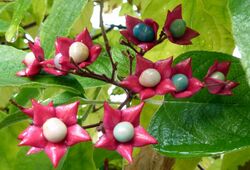Biology:Clerodendrum trichotomum
| Clerodendrum trichotomum | |
|---|---|

| |
| Scientific classification | |
| Kingdom: | Plantae |
| Clade: | Tracheophytes |
| Clade: | Angiosperms |
| Clade: | Eudicots |
| Clade: | Asterids |
| Order: | Lamiales |
| Family: | Lamiaceae |
| Genus: | Clerodendrum |
| Species: | C. trichotomum
|
| Binomial name | |
| Clerodendrum trichotomum Thunb.
| |
Clerodendrum trichotomum, the harlequin glorybower, glorytree or peanut butter tree, is a species of flowering plant in the family Lamiaceae. It is native to China, Korea, Taiwan, Japan, India, and the Philippines.[2][3]
It is a large deciduous shrub, growing 3–6 metres (10–20 ft) high. The leaves are ovate, up to 12 cm (5 in) long, soft and downy or hairy, producing a peanut odor when crushed. The fragrant flowers are borne on branching peduncles. They have white petals, held within a green calyx which turns red as the fruits ripen. The fruits (drupes) are white, changing to bright blue and eventually dark blue on maturity.[4] They contain the novel blue pigment trichotomine.[5]
It is cultivated for its fragrant flowers, autumn colour, and ornamental berries. It is hardy but requires a sheltered position. The variety C. trichotomum var. fargesii (Farges' harlequin glorybower) and the cultivar C. trichotomum var. fargesii 'Carnival'[6] have gained the Royal Horticultural Society's Award of Garden Merit.[7] (confirmed 2017).[8]
Etymology
Clerodendrum is derived from Greek, and means 'chance tree'.[9]
Trichotomum is also derived from Greek, and means 'three-forked' or 'triple-branched'.[9]
References
- ↑ de Kok, R. (2022). "Clerodendrum trichotomum". IUCN Red List of Threatened Species 2022: e.T164941752A164941933. doi:10.2305/IUCN.UK.2022-1.RLTS.T164941752A164941933.en. https://www.iucnredlist.org/species/164941752/164941933. Retrieved 11 October 2023.
- ↑ Wearn, J.A.; Mabberley, D.J.; Bramley, G.L.C. (2019). "Clerodendrum". Flora Malesiana. Series I - Seed Plants. 23 - 2019. The Netherlands: Naturalis Biodiversity Center. pp. 152. ISBN 978-90-6519-019-2.
- ↑ {{citation | mode = cs1 | title = Clerodendrum trichotomum | work = Germplasm Resources Information Network (GRIN) | url = | publisher = [[Organization:Agricultural Research ServAgricultural Research Service (ARS), United States Department of Agriculture (USDA) | access-date = 23 January 2018 }}
- ↑ RHS A-Z Encyclopedia of Garden Plants. United Kingdom: Dorling Kindersley. 2008. pp. 1136. ISBN 978-1405332965.
- ↑ Iwadare S, Shizuri Y, Yamada K, Hirata Y. Synthesis of trichotomine, a blue pigment obtained from Clerodendron trichotomum Thunb. Tetrahedron. 1978; 34(10):1457-1459. doi:10.1016/0040-4020(78)80166-5
- ↑ "Clerodendrum trichotomum var. fargesii 'Carnival'". RHS. https://www.rhs.org.uk/Plants/323029/Clerodendrum-trichotomum-var-fargesii-Carnival-(v)/Details.
- ↑ "Clerodendrum trichotomum var. fargesii". RHS. https://www.rhs.org.uk/Plants/98467/Clerodendrum-trichotomum-var-fargesii/Details.
- ↑ "AGM Plants - Ornamental". Royal Horticultural Society. July 2017. p. 22. https://www.rhs.org.uk/plants/pdfs/agm-lists/agm-ornamentals.pdf.
- ↑ 9.0 9.1 Gledhill, David (2008). "The Names of Plants". Cambridge University Press. ISBN:9780521866453 (hardback), ISBN:9780521685535 (paperback). p 111, 385
Further reading
- Hillier, J. and A. J. Coombes. The Hillier Manual of Trees and Shrubs. David & Charles. 2007.
Wikidata ☰ Q764044 entry
 |


